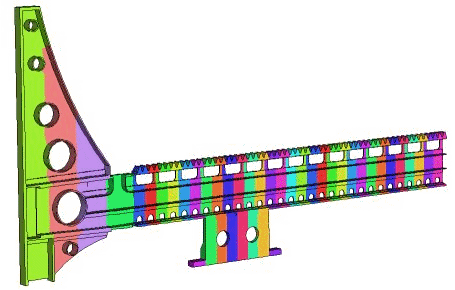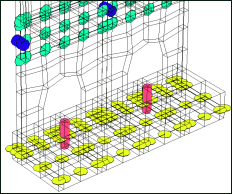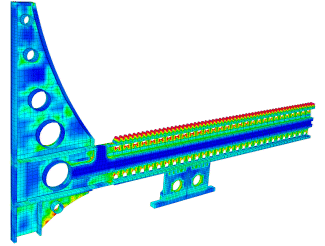Strand7 Software: Case Studies: Rambeam
Coking oven rambeam thermomechanical analysis |
| Strand7 Consulting carried out a transient finite element analysis of a rambeam. One complete pushing cycle, during which the beam moves into and then out of a coke oven, was analysed. |
|
The beam begins the cycle at the ambient air temperature of 30 deg C. During the following 53 seconds, the beam gradually moves into the oven which is at a temperature of 1200 deg C. During this time the rambeam pushes the coke out of the front of the oven into a waiting train. Once the oven has been cleared, the beam is retracted from the oven. This takes a further 53 seconds. The beam then sits in the outside air and slowly cools. |
Background |
| The rambeam has been in service for many years. During this time the beam has suffered from extensive cracking problems. The cracks are repaired on a regular basis by welding. The high maintenance costs associated with the continual repair of the beam are considered to be excessive. Thus the old beam is to be replaced by a beam of new design which, hopefully, does not suffer from cracking problems. |
|
The analysis had two major goals:
|
Model |
| To achieve these goals, two different models were required. One of the original design and one of the new design. Eventually, some 30 revisions were made to the model of the new design before the design was frozen. |

|
|
The model was built as three sub-models: the head, the foot and the beam. These were joined to create the final model. |
|
The movement of the rambeam into and out of the oven was simulated by changing the ambient temperature of the air surrounding the rambeam. The rambeam was divided into 32 sections along its length. The ambient temperature of each section was varied as a function of time, depending on when each section enters and emerges from the oven. |

|
|
The rambeam is constructed from a number of separate parts that are bolted together. From a structural and heat transfer point of view the beam cannot be considered a continuum. The joints will result in a loss of structural stiffness and will provide additional resistance to the flow of heat. Clearly the joint is an important feature of the structure and thus must be included in the finite element model. The manner in which the joints were modelled is illustrated in the figure. The bolt was represented with the beam element having the same mechanical and section properties as the bolt. Heat transfer across the gap was included by connecting small gap elements across the joint. These were assigned heat transfer properties appropriate to the heat transfer across the gap. |
Statistics |
| Nodes | : | 32629 |
| Beams | : | 4278 |
| Bricks | : | 16241 |
| Heat Solver Equations | : | 32629 |
| Static Solver Equations | : | 94483 |
Nonlinear heat transfer analysis |
| The first step in the analysis was to run the Nonlinear Transient Heat Solver to determine the temperature distribution at each of 20 time steps. The modes of heat transfer considered in this analysis were conduction, convection and radiation. The analysis is nonlinear due to the variation of material properties with temperature and the inclusion of radiation in the analysis. |
Stress analysis |
| The second step of the analysis requires running the Nonlinear Transient Dynamic solver for the 20 time steps. The temperatures calculated by the Heat solver are automatically used as nodal temperatures in the Transient Dynamic solver. The loading condition is a thermal expansion caused by the non uniform temperature distribution. The output from each of the 20 time steps includes deflections, stress and strain. The effect of temperature on the properties of the steel was included using structural temperature tables. |
|
Despite the relatively short time of the pushing cycle, the high temperature of the oven means that sections of the rambeam reach temperatures of around 500-600 deg C. The material properties of steel at these elevated temperatures change significantly and thus cannot be considered constant during the analysis. The effect of the temperature on the conductivity, specific heat, convection coefficient, elastic modulus and thermal coefficient of expansion was included in the analysis via temperature tables. |
Results |
| When a structure undergoes a thermal transient it heats up in an uneven manner and temperature gradients develop. Thermal stresses are generated in a structure due to temperature gradients. In the original design, after the beam emerges from the oven, the web remains hot whilst the thinner flanges cool down relatively quickly. This temperature differential generates significant tensile stress in the thin flanges, near the weld line. |

|
|
Cracks will, in general, form and propagate normal to the direction of the maximum tensile stress in the structure. To predict the likelihood of in-service cracking, the results of most interest were the maximum tensile principal stresses. The magnitude of this stress was investigated to ensure that it was below the endurance limit for steel, corresponding to the number of cycles expected. For this particular structure the number of cycles is relatively small and thus failure would result from low cycle fatigue at a relatively high stress. |
|
For more information on thermal analysis, see Strand7 Webnotes - Thermal. |

 Menu
Menu